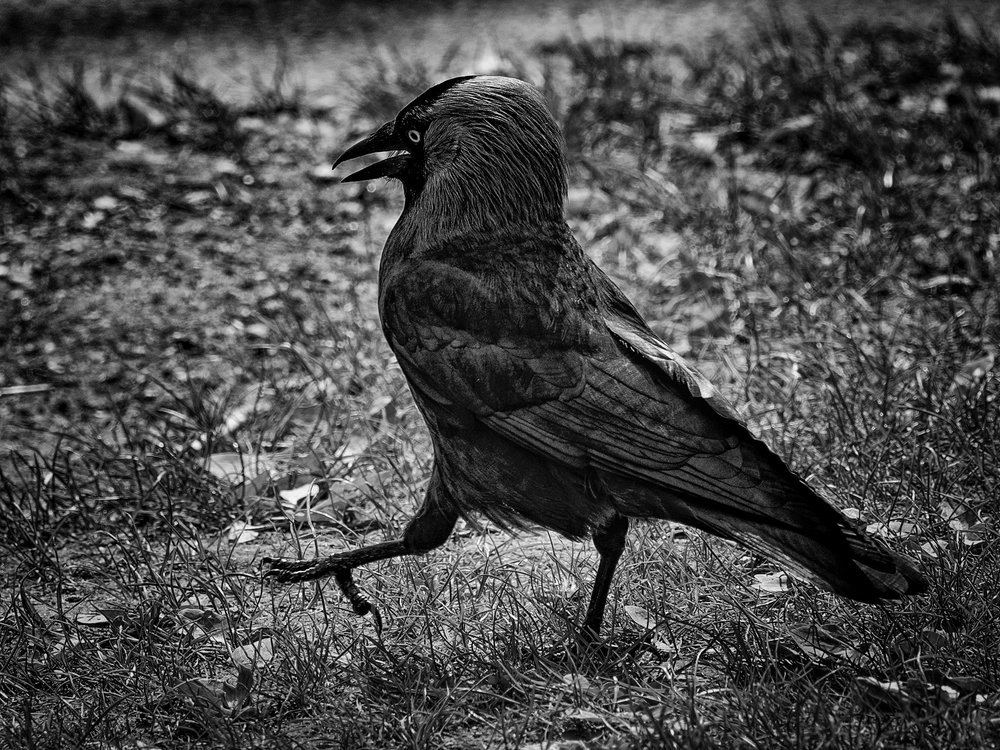
This morning the Photo Rumors site posed this question in the form of a poll. I joined the 52% of respondents (at the time of writing) who answered NO, micro four-thirds is not dead. It’s early days yet, but 36% of respondents actually believe m4/3 is dead (which is demonstrably untrue) while just under 13% are not sure what’s happening. Have your say below…..
The result might have been different if the question had been worded otherwise: Is micro four-thirds dying, rather than dead. If that had been the question, I suspect the YES vote could have been considerably higher.
The truth is, no one knows. I think the 2x crop sensor still has a lot of life in it yet. But there is no doubt that the tremendous exposure of full-frame sensors — particularly in the excitement surrounding the launches by Nikon and Canon — is drawing in more punters. Serious photographers will scrutinise crop-sensor cameras more keenly in future, wondering whether they would be better off with a Z6 or an a7 rather than a relatively expensive camera with a much smaller sensor.

In my view, micro four-thirds still has a lot going for it, not just in the economy of scale when it comes to lenses, but in the ever-improving image quality being squeezed out of the smaller chip.
Perhaps a more apposite question would be whether or not APS-C is dying. If micro four-thirds is under threat from the new full-frame wonders, then APS-C must be at even greater risk. The difference in system size between FF and the 1.5 crop is less dramatic, and the cost of a pro-APS-C system is not that much less than that of a full-frame system.
Indeed, full-frame cameras have become more affordable while, at the same time, crop-sensor systems have become more expensive. Price is therefore no longer of paramount importance in choice. It comes down mainly to size and weight — how much can you manage to carry.
See our feature on the Olympus OM-D E-M I at the London Wetland Centre
In this new world, there is a good argument for considering full-frame cameras against micro four thirds. They offer more performance at the cost of a little more size and weight. APS-C is somewhere in the middle, and you do begin to wonder what future it will have.
The APS-C market is in itself interesting. There is only one company, Fuji, which is wholly committed to the standard. Other players, Sony, Leica, Nikon and Canon, could take it or leave it as their full-frame systems continue to develop. Fujifilm is in an odd position. The X system has been a massive success over the past decade and has a strong, almost messianic following. There are compelling arguments which suggest that Fuji X is all the camera you need, so why bother about full-frame?

Paradoxically, it is the very success of Fuji which has led to the company’s recent decision to shun full-frame in favour of the GFX medium-format. Without a doubt, one of the reasons for this choice was to avoid cannibalising sales of the X system. Yet opting for medium format is either the best of decisions or the worst of decisions. Only time will tell.
In the meantime, if any Fuji cannibalising is done will be by Sony and Nikon in particular with their full-frame systems. Fuji has opted out of the market.
What do you think? Is there room for the APS-C and micro four-thirds in the new full-frame world? Will there be a gradual migration of photographers from crop-sensors?

M43 is certainly not dead. I have a recently purchased system and love the compact quality glass available. The Sigma CEO recently stated that M43 is a great option for those wanting compact. On another note, the rumour of the Leica Q-P looks exciting.
In a recent dp review q&a with Fuji GM , GM said no interest fx because no legacy. then says folks not migrating from x to g series, then talks about entry level Instax possibly getting interchangeable lens to compete w smartphones or more lens for x to compete w smart phones, don’t have clue as to what the sensor is in Instax! I think FX is going to be the survivor.
The only M4?3 I now have is the Leica D-Lux 109; but if the app-c is also going down then my entire CL/TL kit will be obsolescent. Maybe all one needs now is the Sony a6500 for back up, and a good full frame – M10 or A7Rii-iii?
I switched back from Leica M to Olympus µ43 in July, for work. I still have my M gear, but I haven’t used it much in the past couple of months.
There’s this concept of “good enough”. Leaving out the past 100 years of newspaper publishing, i.e. “give us something we have as little additional work to do to get it printed”, well, µ43 is good enough to begin with. Question is: What do you want to do with your files? For News, it means pretty much “can I show it online, or print it inside a 2-3 column in print”, so, 1280px on the long sedge is pretty much the sweet spot. Deliver 6MP so the photo editor can crop some.
So I mainly wonder whether all those people going on about resolution really print Fine Art Prints often enough a µ43 sensor might become a problem. (Disclaimer: I just had my first photo group exhibit, and they printed up to A2, mostly A3, and the pics from my Olympus looked pretty much the same from my Leicas, pixel peeper quality-wise.)
It will be a full-blown marketing-numbers shoot out without any real photographic reasons. More is more. “But dynamic range is worse with µ43 than with a full-frame camera of the same generation”, well, yes, but the print can’t show it, the Web version won’t show it. You might have more lee-way while editing, but frankly, if you need to edit this much that a 10 Bit RAW file isn’t enough you better ought have invested in reflectors or changed your setup. That’s still 3 stops more than you can pull off with what had been all the rage for the past 40 years or so, so, yeah. If µ43 limits you in its dynamic range, you wouldn’t have been able to make a living for decades.
But regarding the main question, µ43 dying or even dead – that’s where the marketing comes in. And marketing is strong, so yes,I think µ43 is done. Not because it can’t deliver, or can’t improve. Not because of dynamic range or resolution. But because full-frame is marketed as the be-all, end-all. Which makes sense, naturally, as Canon and Nikon and Sony and Pentax really want to sell their full-frame cameras. That it isn’t needed for image quality reasons is besides the point. From what we can see nowadays, the only relevant difference is a shallow depth of field, something I actually hate as it runs counter to my job.
But unfortunately loads of the people who have enough of a disposable income think a shallow depth of field is a prime requirement. And, well, they have the money that’s stil around.
I own full-frame (Leica M and Canon) and APS (Fuji X100F).
For the Fuji, sensor size isn’t much of an issue as APS is big enough to give beautiful results including semi-shallow depth of field (especially with the excellent TCL 50mm equiv) and small enough for easy travel and carry. Would being a little smaller or larger make much of a difference?
Generally if I need something smaller than my Leica M, the Fuji is sufficient. If I need something smaller than that, well not much worth worrying about in between an X100 (or Ricoh GR) and and an iPhone.
The Panasonic 14-150mm m4/3 lens is microscopic compared with the massive, arm-achingly heavy and huge ‘equivalent’ Canon 28-300mm lens which I used to drag about.
That’s the beauty of m4/3 ..the lenses are small and light compared with the equivalent (..or fairly equivalent..) "full-frame" lenses. Look at the positively tiny 45mm f1.8 (equivalent – though not, of course, in depth-of-field) to a 90mm f1.8 or f2.
The m4/3 lenses aren’t encumbered with in-lens stabilisation (..that’s in most of the camera bodies, instead..) and the glass is smaller and lighter, which also means that they can focus faster than their bigger "full-frame" equivalents. Olympus’ 12-100mm f2.8 (equivalent to a big, cumbersome, 24-200 f2.8 (though not in d-o-f, I know..) is absolutely excellent.
"Full-frame" cameras are getting – or have got – as small, and light, as m4/3 cameras (..I’m thinking of the Sony A7 series..) but their lenses have not appreciably shrunk, nor got lighter. It all depends what you want: for very low light, then the A7S (or its MkII) and full-frame lenses. For normal light ..and travelling light.. m4/3 and its teeny-weeny really lightweight lenses.
Of course, that’s only my opinion..
To be honest, the new xt3 is not bad. I haven’t played with raw files but only with the jpegs in LR. I sold my A7RIII because of huge files and a shoulder pain issue. I haven’t really missed the dynamic range but have certainly missed the full frame look of lenses such as sonnar 50/1.5. anyway, for me the dynamic range of micro four thirds wasn’t good enough and not better than my pixel 2 phone. Of course you can’t beat value proposition of the micro four thirds when you use lenses such as 45/1.8 or even 20/1.7.
For myself, I’ll no longer be investing in M43s, and I’ve sold off some of my M43s equipment. However, I’ll keep the Panasonic G9 and PanLeica 12-60mm and here’s why: in 2016 we went to Alaska and the GX8 worked flawlessly in all kinds of weather and it was light enough to always carry around. It was the right balance of all the things I was looking for.
I think over the long term, though, M43s will struggle; momentum will slow down until, likely, it becomes unsustainable. Also, Panasonic will now have two lines to invest development into; which one will they prioritize? And you did not mention Olympus – all their eggs are in one basket right now!
APS? Who knows… but I still love my Ricoh GR and it’s the right balance of all the things it does so well! Fuji: well frankly, if they’d change back to a Bayer sensor I might consider them; I’ve dabbled with the xtrans sensor and I’ve always struggled to make it work. I recently learned that their medium format sensors are bayer. There’s also Pentax, similar to Fuji in their sensor commitments, which as far as I’m concerned is no longer a player (which may not bode well for Ricoh/GR). Given they are the "APS companies" right now, perhaps the fate of the APS is intertwined with the fate of Fuji and Pentax.
Personally, my focus over the next couple of years will be on the (FF) L-mount. I’m curious to see where Panasonic (and Leica) go with it. I just wish Leica was releasing those Summicrons faster! And if the APS line had a small suite of Summicrons I might be interested in it too.
All that said, I cannot predict the broader long-term market for various sensors… put me in the "I don’t know" category : )
To take up a theme from a recent article here, the discussion on this has been going since the middle of the 19th Century. Full plate, half plate, quarter plate, anyone? Perhaps computational photography might change this, but only a bit. We could then get discussions about the number of sensors and ‘mine has more than yours’ etc. As Mike points out, at a recent meeting in Wetzlar Stefan Daniel said that Leica was keeping an eye on this, but he did not seem in any hurry. Proof of concept is much more than getting a prototype out or even some traction from early adopters. The market has to move. Who was it said that " you can’t buck the markets" ? We live in a disposable world now and last month’s ‘digi-wonder’ is often now this month’s ‘has been’. The market will decide on m4/3 just as it did with other formats. Somehow, I doubt that people will be messing around with m4/3 150 years from now in the same the way that some wet plate collodion enthusiasts do today with their 150 year old technology.
William
Another factor that may influence which sensor sizes survive is the development of computational photography, as seen in both recent smartphones and in the Light L16 camera. While the consistent and predictable quality of the results from computational computing is not there yet, it improves yearly.
Using multiple smaller sensors in a single body right now is limited to flat rectangles (smartphone & the L16), but for those who value composing with a viewfinder (EVF) rather than a LCD screen, there may come a time when the haptics of the camera body more closely resemble the controls of a traditional camera.
Bear in mind that in July 2018, Leica made an investment in the Light company (https://spot.light.co/light-series-d-softbank-leica).
A very well-made point. Indeed the Light project was referred to in passing as part of a presentation by Stefan Daniel when I was at Leica a month ago. I sense we are in a period of change. The digital camera has now truly come of age and early alliances and conventions are now becoming malleable. Cropped sensors achieved popularity because of the high cost (or early
non-availability) of full-frame sensors — whatever other qualities such as size and weight we now add into the equation. Sensor cost is no longer such an issue and, without doubt, they will become cheaper, thus further eroding the financial benefit of choosing Mft or APS-C. It will be interesting to see how things pan out.
I bought a Light L16 via its Kickstarter campaign, and waited two years for it to be delivered, and when it was – it was ridiculous. I sent it back and got a full refund.
It was poor at stitching together the various (..five-sensors-at-a-time – if I remember correctly..) images; poor at ‘defocusing’ the background via its slow and cumbersome computer interface; only gave its full resolution at a handful of zoom settings; was ENORMOUS and awkward compared with, say, an iPhone (and the phone’s two ‘computational photography’ lenses).
They didn’t quibble, and refunded immediately. By the time the L16 actually arrived, phone companies had done better, and faster, than Light (..so to speak..) and their future (Light’s) now seems to be in licensing some technology to other camera – and phone – makers.
It was a bright idea ..but they took too long implementing it (..after having let the cat out of the bag..) and getting their first product up and running. They should have relied on venture capital funding instead of Kickstarter, to my mind.
When you posted the article with the sensor size diagram the other day, I hadn’t considered how many different sizes were currently out there. And as we have seen with the decline of point and shoot digital cameras rapidly being erroded by the mobile phone, I suspect potentially over the coming years that this will occur with sensor types too. This in my view is both natural and inevitable.
However which sensor sizes will survive could be anyone’s guess, as I know photographers who use a whole range of difference camera’s – some who use multiple different types. My recent(ish) uses of the M10, and my purchase of the Df have shown how much more image quality and wider dynamic range is available from the full frame sensor over my APSC cameras, something I didnt know about until I started using them regularly. I am not sure what this will mean for my future camera purchases, but I am enjoying the increased flexibility of the Df files post process wise, and they are the similar sized files to my APSC Leica X.
Dave S
Very interesting, Mike. I think another element in the equation must be the high standard of IQ in the 1" sensor world – so that MFT is squeezed from both ends. I think the argument for MFT is undoubtedly in the lightweight zoom area, as you point out. If my dealer hadn’t side-tracked me into NEX when I was moving up from compact in 2012, then I’m sure I should be an MFT addict by now. File size for those of us with older computers/macs could be a reason for staying off FF – as well as the inevitable increase in lens weight, however much smaller the camera bodies may get. As for Fuji, I bought an X-T20 earlier this year, and it has completely convinced me to stay with my X-Vario! I did two identical shoots recently and the contrast between the fiddly programming of the Fuji and the lovely simplicity of the Leica made all the difference to the pleasure of taking photos. Given that the XV produced just as good images as the Fuji, in colour or mono – to my eyes – I know where the future lies for me. (But if only Olympus and Panasonic would stop making such attractive pieces of equipment……….!)